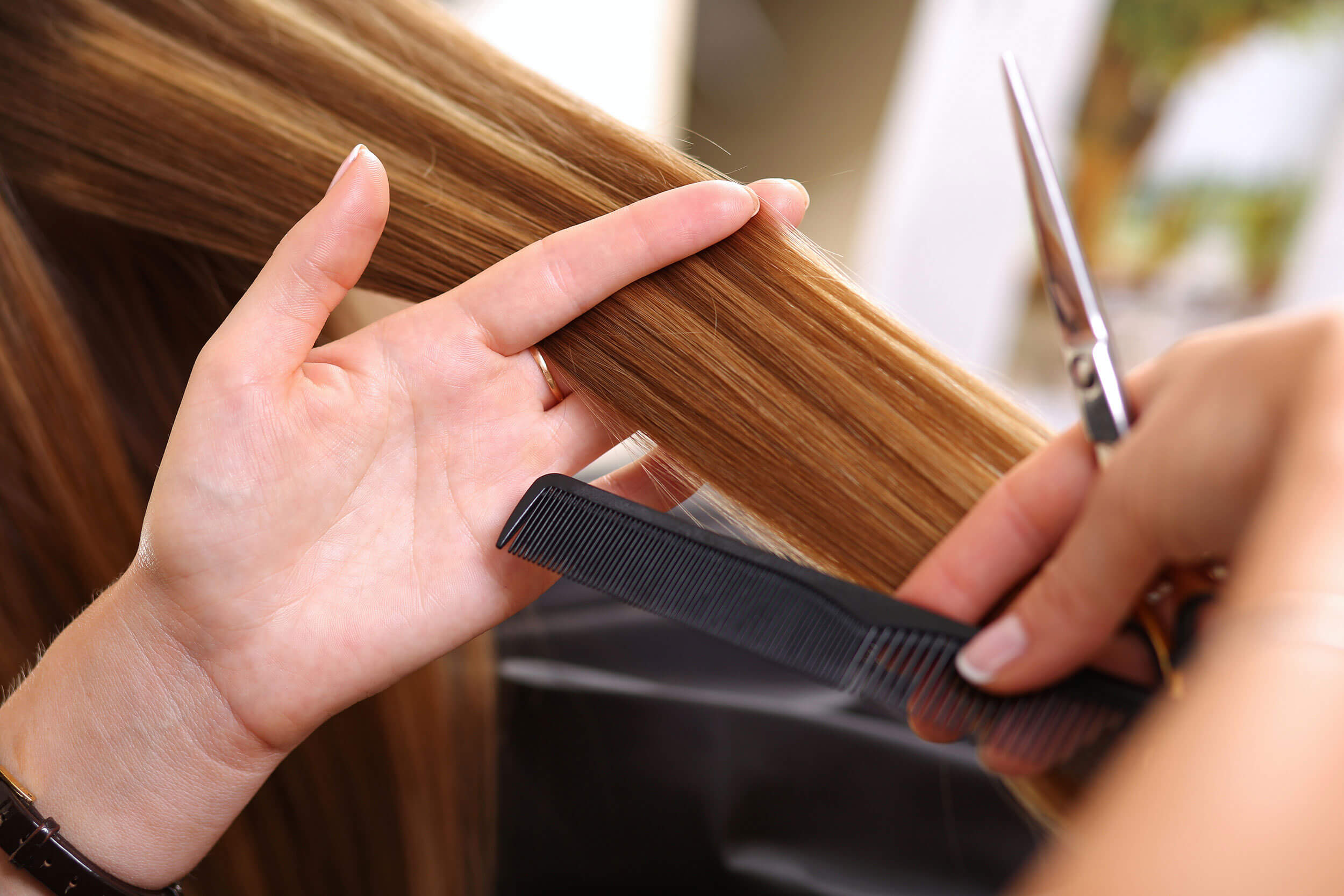Table Of Content
- Useful Health Benefits of Chamomile Tea
- How to Repair Hair (When You’re Obsessed with Heat Styling)
- Disguise Split Ends With a Nourishing Oil
- Your Complete Guide to Hair Care and Styling for 3B Hair Type
- Can You Use Purple Toning Shampoo On Brown Hair?
- Act + Acre Cold Processed Leave-In Conditioner
- Be gentle on your strands.

One way to prevent overall heat damage is to give your strands a break from all styling tools at least once a week. To reduce the actual heat damage from your styling tools, select ceramic versions — these heat up more evenly so you don’t have to keep using them on the same sections of hair repeatedly. Sturdivant-Drew recommends Matrix's A Curl Can Dream Rich Mask ($19) for natural hair that has been damaged by heat. "It has manuka honey in it, which helps to moisturize and repair hair, leaving it smooth and frizz-free," she says. She also suggests the brand's Instacure collection includes an Anti-Breakage Conditioner ($22), which works to nourish, repair, and strengthen dry, damaged, and brittle hair.
Useful Health Benefits of Chamomile Tea
Are Split-End Trimmers Worth The Hype? We Asked A Hairstylist - Glam
Are Split-End Trimmers Worth The Hype? We Asked A Hairstylist.
Posted: Fri, 03 Nov 2023 07:00:00 GMT [source]
Using heated appliances on your hair, especially on a daily basis, can dry it out and change the structure of your hair proteins. Keeping your hair well-nourished by conditioning and reducing heat, along with other practices, can help prevent split ends. Make sure you sign up for our newsletter below to stay up to date with the latest haircare tips and tricks.
How to Repair Hair (When You’re Obsessed with Heat Styling)
From heat damage to dyeing, you’d be surprised to know how easy it is for your hair to splay out into two (or, gulp, more) parts at the tips. Mix 3 tablespoons of oil with 2 tablespoons of honey, and apply this mixture to wet hair, especially on the ends, after shampooing. Almond oil and olive oil help soften, strengthen, and repair the hair. They also provide nutrients such as fatty acids, protein, and vitamin E to the hair.
Disguise Split Ends With a Nourishing Oil
As an added bonus, honey is “great for treating a dry scalp and boosting shine,” says extension specialist, Melissa Brown. Split ends are the frayed tips of hair that have, yes, split into two or more parts due to dryness or damage. It’s easy to get rid of split ends by cutting them off, but it’s also important to know what caused them in the first place. Although you might have no intention of eliminating your styling tools, using them a little less and keeping your hair well-conditioned may help prevent hair breakage. Exposure to extreme weather conditions, and hair care techniques such as blow drying, straightening, and curling may cause split ends. With so many people using hair products daily, split ends are common.
Your Complete Guide to Hair Care and Styling for 3B Hair Type
Regardless of what type of split end has occurred, there should be no mistaking it when you see the obvious signs of damage. Best practice for trims is every three months for the sake of hair health. If you want to keep your cut looking aesthetically polished, then your trim schedule will depend on the length and style of your hair—you can read more about that here. "Split ends are most easily remedied by trimming off," Hans says. If you're in a pinch and need your hair looking pristine ASAP, then a trim is your best bet. You don't have to cut off much, but at least dusting the ends will work wonders for the look, feel, and health of your hair.

No matter your hair type or texture, you can suffer from split ends. "Trichoptilosis is the medical term for split ends," explains dermatologist Shari Sperling. We asked Sperling and hair stylist Arsen Gurgov to explain all we need to know about split ends—from what causes them to how to prevent them.
Many people assume that the problem of split ends is limited to the hair tips, but this form of hair damage can occur anywhere along the length of the hair. Candle cutting requires twisting a section of your hair and burning it halfway through with a lighted candle. It’s thought that burning off your split ends can create a seal to help protect the ends from splitting again. Still, some hair care experts worry it may actually cause split ends and damage hair follicles. Excessive split ends are usually a symptom of more extensive damage to your strands.
Common Questions About Split-ends Answered By Harvard Health Publishing. - MSN
Common Questions About Split-ends Answered By Harvard Health Publishing..
Posted: Tue, 16 Apr 2024 01:33:23 GMT [source]
You can also leave a towel in your hair as a temporary measure to absorb excess water. From a traditional split to a feather split, there are a whopping 16 different types of split ends! Resist the urge to pick at your ends by getting a hair dusting, a method of haircutting that rids your hair of split ends without relinquishing all of the hard work you put in to grow it out. Chemicals can cause severe damage if they're not applied correctly. Make sure you're applying color to just the roots when you're doing a touch-up so that your ends don't get fried by too many chemicals. You'll want to massage the shampoo deeply into your scalp (perhaps even add a scalp massage) and then let the water run down through the rest of your hair.
Be gentle on your strands.
Apply it as a leave-in moisturizer, then style your hair as usual. Scalp care is something we should all start incorporating into our beauty routines, as scalp is skin after all. Whether you wash your hair once a week or daily, keep an eye on what your scalp needs.
In any case, you must check your hair regularly for signs of damage or split ends, and go for regular trims. The idea is to catch the problem early before it spreads to the rest of the hair and causes deeper-level damage, which is usually difficult to treat. You have to be mindful about your daily hair grooming practices, especially if you are prone to split ends.
When damage occurs to your hair, it results in your hair becoming weak and prone to breakage or splitting. Eventually, thinning of the hair and bald spots may occur as a result of the continuing and untreated damage. Even though there’s no way to repair split ends, you can make the damage less noticeable. One option is to apply coconut oil, almond oil, or another type of moisturizer to the ends of your hair.
Additionally, the tool you use to detangle could also be the reason your ends split. "If you are using a brush with rough bristles right out of the shower, your hair is going to break," says Polko. Remember that saying about brushing your hair for 100 strokes a day?
If you do need to use heated appliances, try to turn down the heat setting. You can also apply a heat protectant product before blow-drying or styling to avoid heat damage. Once a week, give your hair some extra TLC with a reparative deep conditioner to speed up the recovery process and strengthen your strands.
You may even notice new hairs that break off in the middle of the growing cycle. If you or a loved one is living with an eating disorder, hair damage is a possible symptom. Instead of rubbing water out of your hair, blot an absorbent towel around your hair instead.
If you do notice some split ends, this could be a sign that you’re due (or overdue) for a visit to the salon. Getting regular trims is one of the best ways to strengthen hair health and prevent future split ends. "After showering, wrap your hair in a microfiber towel and let the towel absorb the excess moisture," Gurgov says. "You can pat your hair gently with the towel if you need to." He also adds that brushing your hair when it's wet can cause breakage. "If you must, use a wide-tooth comb to detangle your hair (it's more delicate on strands compared to a brush) along with a spray-in conditioner." This is the most common type of split end, and they're easily formed.
No matter how much smoothing serum you use, too many split ends can make hair look unhealthy—which is why it's almost always suggested to get rid of them via a haircut. But if you feel like split ends sneak up on you too quickly, there are certain practices and hair treatments that can protect against breakage and prolong healthy ends. We asked celebrity hairstylist Orlando Pita, and Ryan Trygstad, co-owner of Mark Ryan Salon, for their expert tips on all things split ends—read on for their recommendations, then get thee to your stylist. "Without the heat from the scissors, the cuticle stays open, whereas hot scissors (with temperatures up to 310º F) help to seal the end of the hair shaft," he says. This is meant to reduce damage and allows the hair to better retain moisture.

No comments:
Post a Comment